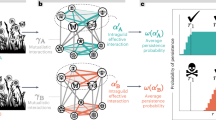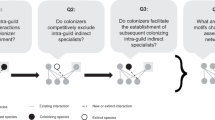Abstract
The loss of a species from an ecological community can trigger a cascade of additional extinctions; the complex interactions that comprise ecological communities make the dynamics and impacts of such a cascade challenging to predict. Previous studies have typically considered global extinctions, where a species cannot re-enter a community once it is lost. However, in some cases a species only becomes locally extinct, and may be able to reinvade from surrounding communities. Here, we use a dynamic, Boolean network model of plant–pollinator community assembly to analyze the differences between global and local extinction events in mutualistic communities. As expected, we find that compared to global extinctions, communities respond to local extinctions with lower biodiversity loss, and less variation in topological network properties. We demonstrate that in the face of global extinctions, larger communities suffer greater biodiversity loss than smaller communities when similar proportions of species are lost. Conversely, smaller communities suffer greater loss in the face of local extinctions. We show that targeting species with the most interacting partners causes more biodiversity loss than random extinctions in the case of global, but not local, extinctions. These results extend our understanding of how mutualistic communities respond to species loss, with implications for community management and conservation efforts.





Similar content being viewed by others
References
Albert R, Jeong H, Barabasi AL (2000) Error and attack tolerance of complex networks. Nature 406(6794):378–382
Allesina S, Tang S (2012) Stability criteria for complex ecosystems. Nature 483(7388):205–208
Almeida-Neto M, Guimarães P, Guimarães PR, Loyola R, Ulrich W (2008) A consistent metric for nestedness analysis in ecological systems: reconciling concept and measurement. Oikos 117(8):1227–1239
Arii K, Parrott L (2004) Emergence of non-random structure in local food webs generated from randomly structured regional webs. J Theor Biol 227:327–333
Baiser B, Buckley HL, Gotelli NJ, Ellison AM (2012) Predicting food-web structure with metacommunity models. Oikos. doi:10.1111/j.1600-0706.2012.00005.x
Barnosky A, Matzke N, Tomiya S, Wogan G, Swartz B, Quental T, Marshall C et al (2011) Has the Earth’s sixth mass extinction already arrived? Nature 471(7336):51–57
Barrows E (1976) Nectar robbing and pollination of Lantana camara (Verbenaceae). Biotropica 8(2):132–135
Bascompte J, Jordano P (2007) Plant-animal mutualistic networks: the architecture of biodiversity. Annu Rev Ecol Evol Syst 38(1):567–593
Bascompte J, Jordano P, Melián C, Olesen JM (2003) The nested assembly of plant–animal mutualistic networks. Proc Natl Acad Sci 100(16):9383–9387
Bastolla U, Fortuna M, Pascual-García A, Ferrera A, Luque B, Bascompte J (2009) The architecture of mutualistic networks minimizes competition and increases biodiversity. Nature 458(7241):1018–1020
Campbell C, Yang S, Albert R, Shea K (2011) A network model for plant–pollinator community assembly. Proc Natl Acad Sci 108(1):197–202
Campbell C, Yang S, Shea K, Albert R (2012) Topology of plant-pollinator networks that are vulnerable to collapse from species extinction. Phys Rev E 86(2):021924
Dunn R, Harris N, Colwell R, Koh LP, Sodhi N (2009) The sixth mass coextinction: are most endangered species parasites and mutualists? Proc R Soc B: Biol Sci 276(1670):3037–3045
Dunne J, Williams R (2009) Cascading extinctions and community collapse in model food webs. Philos Trans R Soc B: Biol Sci 364(1524):1711–1723
Dunne J, Williams R, Martinez N (2002) Network structure and biodiversity loss in food webs: robustness increases with connectance. Ecol Lett 5(4):558–567
Dunne J, Williams R, Martinez N (2004) Network structure and robustness of marine food webs. Mar Ecol Prog Ser 273:291–302
Estes J, Palmisano J (1974) Sea otters: their role in structuring nearshore communities. Science 185(4156):1058–1060
Fortuna M, Bascompte J (2006) Habitat loss and the structure of plant–animal mutualistic networks. Ecol Lett 9(3):281–286
Franzén M, Nilsson S (2009) Both population size and patch quality affect local extinctions and colonizations. Proc R Soc B: Biol Sci 277(1678):79–85
Hastings A, Wolin C (1989) Within-patch dynamics in a metapopulation. Ecology 70(5):1261–1266
Jabot F, Bascompte J (2012) Bitrophic interactions shape biodiversity in space. Proc Natl Acad Sci 109(12):4521–4526
James A, Pitchford J, Plank M (2012) Disentangling nestedness from models of ecological complexity. Nature 487(7406):227–230
Jordano P, Bascompte J, Olesen JM (2003) Invariant properties in coevolutionary networks of plant–animal interactions. Ecol Lett 6:69–81
Jordano P, Bascompte J, Olesen JM (2006) The ecological consequences of complex topology and nested structure in pollination webs. In: Waser NM, Ollerton J (eds) Specialization and generalization in plant-pollinator interactions. University of Chicago Press, Chicago, pp 173–199
Kaiser-Bunbury C, Muff S, Memmott J, Müller C, Caflisch A (2010) The robustness of pollination networks to the loss of species and interactions: a quantitative approach incorporating pollinator behaviour. Ecol Lett 13(4):442–452
Memmott J, Waser NM, Price M (2004) Tolerance of pollination networks to species extinctions. Proc R Soc Lond Ser B: Biol Sci 271(1557):2605–2611
Olesen JM, Jordano P (2002) Geographic patterns in plant-pollinator mutualistic networks. Ecology 83:2416–2424
Olesen JM, Bascompte J, Dupont Y, Jordano P (2007) The modularity of pollination networks. Proc Natl Acad Sci 104(50):19891–19896
Petchey O, Eklöf A, Borrvall C, Ebenman B (2008) Trophically unique species are vulnerable to cascading extinction. Am Nat 171(5):568–579
Peter C, Johnson S (2008) Mimics and magnets: the importance of color and ecological facilitation in floral deception. Ecology 89(6):1583–1595
Ramos-Jiliberto R, Albornoz AA, Valdovinos FS, Smith-Ramírez C, Arim M, Armesto JJ, Marquet PA (2009) A network analysis of plant-pollinator interactions in temperate rain forests of Chiloe Island, Chile. Oecologia 160:697–706
Ramos-Jiliberto R, Valdovinos FS, Moisset de Espanés P, Flores JD (2012) Topological plasticity increases robustness of mutualistic networks. J Anim Ecol 81:896–904
Saadatpour A, Albert R (2012) Boolean modeling of biological regulatory networks: a methodology tutorial. Methods. doi:10.1016/j.ymeth.2012.10.012
Srinivasan U, Dunne J, Harte J, Martinez N (2007) Response of complex food webs to realistic extinction sequences. Ecology 88(3):671–682
Stang M, Klinkhamer P, Waser NM, Stang I, van der Meijden E (2009) Size-specific interaction patterns and size matching in a plant–pollinator interaction web. Ann Bot 103(9):1459–1469
Thébault E, Fontaine C (2010) Stability of ecological communities and the architecture of mutualistic and trophic networks. Science 329(5993):853–856
Valdovinos FS, Ramos-Jiliberto R, Flores JD, Espinoza C, López G (2009) Structure and dynamics of pollination networks: the role of alien plants. Oikos 118:1190–1200
Valdovinos FS, Moisset de Espanés P, Flores JD, Ramos-Jiliberto R (2012) Adaptive foraging allows the maintenance of biodiversity of pollination networks. Oikos. doi:10.1111/j.1600-0706.2012.20830.x
van Nouhuys S, Hanski I (2005) Metacommunities of butterflies and their parasitoids. In: Leibold M, Holt R, Holyoak M (eds) Metacommunities: spatial dynamics and ecological communities. Univ. Chicago Press, Chicago, pp 99–121
Vázquez D, Aizen M (2004) Asymmetric specialization: a pervasive feature of plant–pollinator interactions. Ecology 85(5):1251–1257
Wang RS, Saadatpour A, Albert R (2012) Boolean modeling in systems biology: an overview of methodology and applications. Phys Biol 9:055001
Acknowledgments
We acknowledge members of the Shea research lab for helpful discussions during the preparation of this research. This work was supported by NSF grant DEB-0815373 and an NSF REU to K.S., NSF grant PHY 1205840 to R.A., and the Biology Department (Presbyterian College) to SY.
Author information
Authors and Affiliations
Corresponding author
Rights and permissions
About this article
Cite this article
LaBar, T., Campbell, C., Yang, S. et al. Global versus local extinction in a network model of plant–pollinator communities. Theor Ecol 6, 495–503 (2013). https://doi.org/10.1007/s12080-013-0182-8
Received:
Accepted:
Published:
Issue Date:
DOI: https://doi.org/10.1007/s12080-013-0182-8




